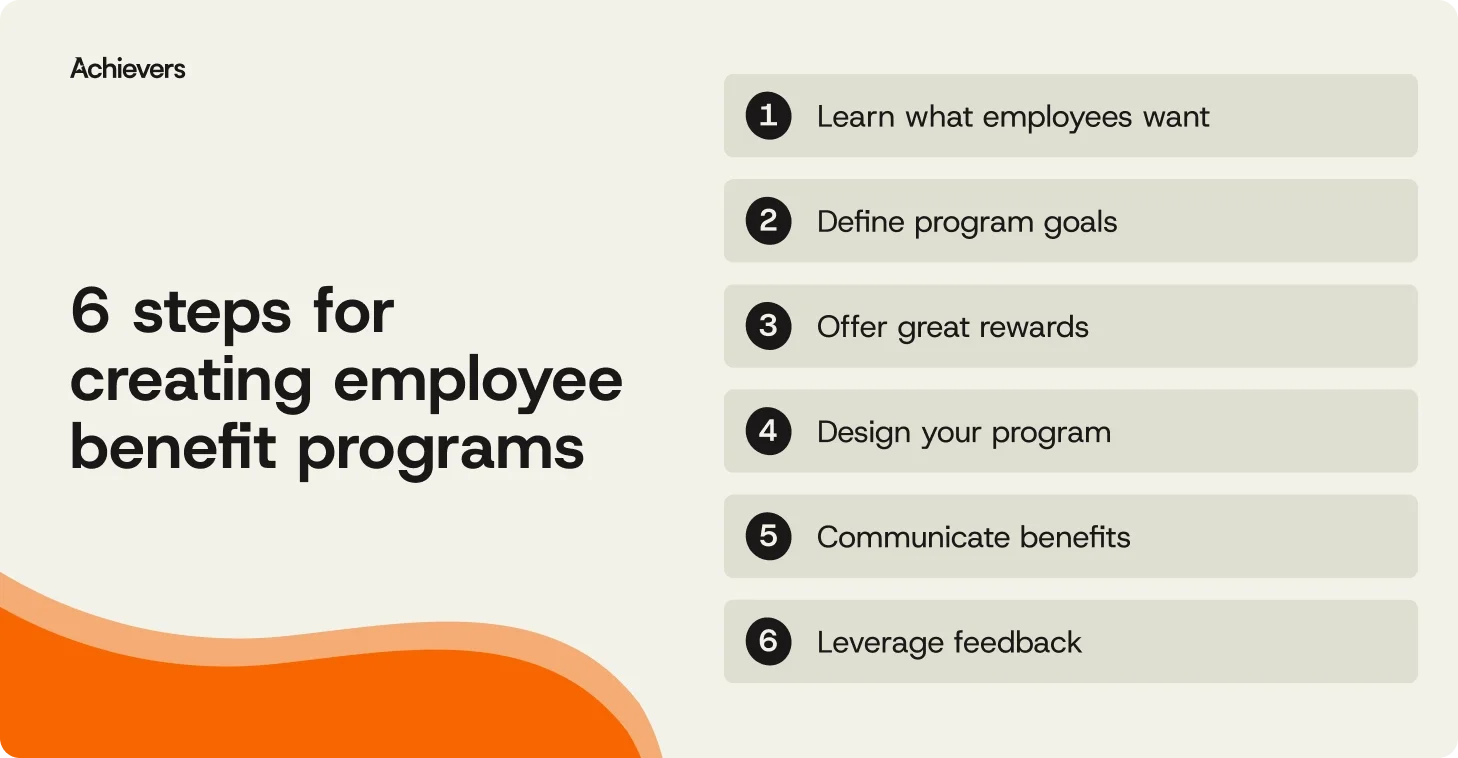Table of contents
When you think of employee benefit programs, your mind probably jumps to the usual suspects: health insurance, retirement plans, maybe a gym discount or two. Maybe you’ve even marked your calendar for Employee Benefits Day. But here’s the thing — many organizations stop there. And when they do add to their benefits lineup, it’s often a scattershot of perks that rarely evolve or resonate.
Today’s employees expect more — and they’re not shy about it. The workforce is more empowered than ever, and that means benefit programs need to do more than check a box. They need to attract great people, keep them engaged, and prove that your organization truly gets what matters most.
The good news? You don’t need a massive budget or a corporate army to build something impactful. These six simple steps will help you create a benefits program that actually benefits your people.
6 steps for creating employee benefit programs
Building employee benefit programs isn’t just about offering a few perks and calling it a day. It’s about showing your people that you understand what they value — and proving that you’re willing to invest in it. The good news? A thoughtful program doesn’t have to be flashy or expensive. It just needs to be strategic, personal, and built with your workforce in mind.
Here’s where to start:

1. Learn what your employees want
Spoiler: it’s not just pizza Fridays. 28% of employees say compensation is the top reason they’d walk away from their current job, with career growth, flexibility, and recognition close behind, according to the Achievers Workforce Institute’s (AWI) Engagement and Retention Report (EOR).
Every team has its own mix of priorities, so skip the assumptions and go straight to the source. Use surveys, pulse checks, or a real-time engagement platform to find out what your employees want more of — and what they could happily live without. That input is your blueprint for benefits that actually matter.
2. Define your program’s goals
Benefit programs without goals are like treadmills without power — a lot of effort, not much progress. Whether you’re trying to win over new hires or keep long-time employees from jumping ship, it pays to get clear on your objectives from the start.
Here are a few common goals worth targeting:
- Attracting stronger candidates
- Reducing employee turnover
- Upping productivity
- Lifting morale
- Improving engagement
- Supporting work-life balance
- Reinforcing positive behaviors
Being intentional and upfront makes it easier to measure impact later, and helps ensure your budget’s being put to good use.
3. Offer great rewards
Appreciation is one benefit that sticks, especially when it comes with rewards that feel personal and meaningful. Combine that with recognition and rewards software integrated into your benefits program, and you’re turning everyday appreciation into a powerful engagement tool.
Here’s how to make it work:
- Give employees a monthly points allowance to recognize great work
- Let team members choose rewards that actually resonate with them
- Centralize recognition in a platform that fits into daily workflows
- Use social recognition to build culture and peer connection
- Keep it budget-friendly while offering real value
4. Design your program
Now that you know what your employees want, what your organization needs, and how rewards can fit into the mix, it’s time to bring your program to life. That starts with smart prioritization — and a little reality check around budget and compliance.
Here’s how to break it down:
- Start with the must-haves: Cover your legal bases first. Make sure you follow all relevant employment laws and requirements.
- Factor in mandated benefits: Think family or medical leave, workers’ comp, disability, unemployment insurance — the essentials.
- Consider your company size: Rules can vary depending on your headcount, so check what applies to you.
- Budget realistically: Once the non-negotiables are in place, look at your available budget and align your choices with your goals.
- Explore voluntary benefits: Think low-cost, high-impact offerings like flexible work, wellness initiatives, or points-based recognition that employees can actually get excited about.
- Support professional growth: Career development benefits — like tuition reimbursement or learning stipends — send a clear message: you’re invested in your people’s future.
The goal here isn’t to offer everything. It’s to offer what matters — in a way that’s thoughtful, sustainable, and aligned with both your culture and business goals.
5. Communicate your benefits to employees
Even the most thoughtful employee benefit programs can fall flat if no one understands them. That’s why clear, compelling communication is key.
Break things down in plain language. Explain not just what you’re offering, but why it matters — whether it’s how your 401(k) match works or how to make the most of paid time off. At the end of the day, clarity builds trust. Trust builds engagement.
6. Leverage feedback to make your program better
A great benefits program is a living, breathing part of your employee experience — and it should grow with your team.
Gather regular feedback through pulse surveys, anonymous tools, or your employee engagement platform. Use that data to find out what’s working, what’s wasting budget, and what your people are asking for next (hello, hybrid flexibility). The more you listen, the more your program reflects what your team needs — and that’s what drives real impact.
Because when your benefits evolve with your workforce, you’re not just checking a box. You’re building a culture that adapts, improves, and listens.
What to include in employee benefit programs
Great benefit programs aren’t built on perks alone — they’re built on purpose. The best ones reflect what employees need to feel supported, motivated, and seen, both in and out of work. Here are the essentials worth including:
Employee recognition
Recognition is one of the fastest ways to build connection and culture — and it pays off. Achievers Workforce Institute found that 80% of employees who are recognized meaningfully at least once a month would recommend their workplace to others.
Platforms like Achievers make it easy to build recognition into the flow of work, so it happens often, feels genuine, and reinforces the values that matter.
To make recognition stick:
- Include recognition from all directions — manager, cross-functional, peer-to-peer
- Make it real-time, specific, and tied to company values
- Blend social and monetary appreciation
- Keep it easy and consistent with a centralized system
- Create visibility across teams so recognition reinforces culture
Employee rewards
Today’s employees aren’t looking for one-size-fits-all rewards — they want options that feel personal. Flexible, meaningful rewards show people you value their effort and their individuality.
With a platform like Achievers, employees can give and receive recognition points, then choose meaningful rewards that resonate. It’s flexible, scalable, and fits any budget.
Build your program around:
- A points-based system that empowers peer recognition
- A wide reward marketplace — from experiences to PTO
- Low-lift admin tools that make program management easy
- Personalization options to make rewards feel authentic
- Integration with your broader engagement and recognition strategy
Wellness programs
Wellbeing isn’t a wellness week and a fruit bowl. It’s a strategy. SHRM’s 2024 survey found that 70% of organizations prioritize flexible work benefits and 48% include wellness in their packages, because healthy employees stick around longer, show up better, and perform at their best.
Here’s how to make an impact:
- Offer stress-reducing options like yoga or mindfulness programs
- Support chronic condition management and health challenges
- Bring in expert-led sessions or wellness perks that actually resonate
- Think whole-person wellness, not just physical fitness
Flexible work schedules
Work flexibility is one of the top reasons employees decide whether to stay or go — it ranks third overall, according to the EOR Report. That makes it more than a convenience; it’s a deciding factor. Offering flexibility signals that you trust your people to manage their time and do great work, no matter where they are.
Consider these benefits:
- Offer hybrid, remote, or flexible-hour options
- Experiment with four-day workweeks or staggered shifts
- Prioritize outcomes over face time
- Make flexibility accessible across roles, not just office-based ones
Career development opportunities
No one wants to feel like they’re in a dead-end role with a shiny title. Growth matters — not just for career trajectories, but for motivation, performance, and staying power. In fact, employees who don’t feel supported in achieving their personal and development goals are 1.8x less likely to exceed performance expectations, according to AWI.
Try this approach:
- Offer access to learning stipends, tuition reimbursement, or online courses
- Make internal career paths clear, visible, and navigable
- Provide mentorship or coaching opportunities tied to real growth
- Make development a regular topic, not an annual check-the-box
Transparency and feedback
Feedback shouldn’t feel like a performance review — it should feel like a conversation. Creating a culture of transparency keeps employees aligned, engaged, and invested in doing their best work.
Here’s how to center transparency:
- Send regular pulse surveys or check-ins, and share the results
- Highlight what’s changing based on employee feedback
- Train managers to ask open-ended questions and listen actively
- Create space for two-way conversations, not one-way reviews
- Use feedback insights to guide recognition, development, and team goals
Turn employee benefit programs into your retention engine
Good employee benefit programs cover the essentials. Great ones make people feel genuinely supported. The difference? Recognition and feedback — and the tools to do both well.
A recognition platform like Achievers makes it easy to bake meaningful, personalized rewards into your benefits strategy. When employees can choose rewards that matter to them, recognition becomes more than a gesture — it becomes a reason to stay.
Layer in a Voice of Employee solution, and you’ve got a real-time read on how your team feels about what you’re offering. Surveys, quick polls, and anonymous feedback channels help you cut through the guesswork and act on what you hear.
Put them together, and your program stops being a checklist and starts becoming a reason people choose to stay.


